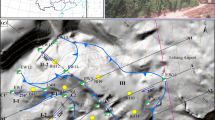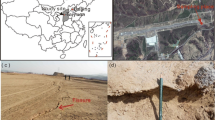Abstract
In recent years, many hill flattening and gully filling projects are carried out in the northwest of China to create land for construction. These projects have formed a number of loess fill slopes, which are prone to failure induced by rainfall. However, the failure mechanism of loess fill slope is not clear under rainfall conditions. In this study, a flume model experiment is carried out to reveal the characteristics and mechanism of failure loess fill slopes. The volumetric water content, soil pressure, and pore water pressure are analyzed to investigate the effect of rainfall infiltration on fill slope. The results shown that rain-induced failure mode of loess fill slopes exhibited progressive multi-stage sliding characteristics, including slope toe failure, crack development and penetration, local sliding, and overall misaligned sliding stages. The influence of the weak interface between the fill slope and the bedrock/natural slope on slope damage was revealed based on the hydromechanical characteristics. It is shown that the maximum migration rate of wetting front along the weak interface is about 5 times that in loess fill, and the weak interface becomes the dominant channel controlling the hydrological characteristics of the slope, accelerating the saturation of the fill loess slope and generating seepage forces towards the outside of the slope, causing the loess fill slope prone to shear slide along with weak interface. Therefore, we believe that the weak interface between the fill slope and the bedrock/natural slope surface plays an important role in slope failure.













Similar content being viewed by others
References
Abramson L, Lee T, Sharma S, Boyce G (1996) Slope stability and stabilization methods. Wiley, New York, p 629
Askarinejad A, Akca D, Springman SM (2018) Precursors of instability in a natural slope due to rainfall: a full-scale experiment. Landslides 15:1745–1759. https://doi.org/10.1007/s10346-018-0994-0
ASTM (2017) Standard practice for classification of soils for engineering purposes (unified soil classification system). ASTM standard D2487- 17. West Conshohocken, Pennsylvania: American Society for Testing Materials
Bentley MJ, Foster JM, Potvin JJ, Bevan G, Sharp J, Woeller DJ, Take WA (2023) Surface displacement expression of progressive failure in a sensitive clay landslide observed with long-term UAV monitoring. Landslides 20:531–546. https://doi.org/10.1007/s10346-022-01995-4
Chang Z, Huang F, Huang J, Jiang S-H, Zhou C, Zhu L (2021) Experimental study of the failure mode and mechanism of loess fill slopes induced by rainfall. Eng Geol 280. https://doi.org/10.1016/j.enggeo.2020.105941
Chen G, Meng X, Qiao L, Zhang Y, Wang S (2018) Response of a loess landslide to rainfall: observations from a field artificial rainfall experiment in Bailong river basin, China. Landslides 15:895–911. https://doi.org/10.1007/s10346-017-0924-6
Chen WW, Zhang S (2021) Gis-based comparative study of Bayes network, Hoeffding tree and logistic model tree for landslide susceptibility modeling. Catena 203. https://doi.org/10.1016/j.catena.2021.105344
Chen Y, Li B, Xu Y, Zhao Y, Xu J (2019) Field study on the soil water characteristics of shallow layers on red clay slopes and its application in stability analysis. Arab J Sci Eng 44:5107–5116. https://doi.org/10.1007/s13369-018-03716-3
Cho SE (2016) Stability analysis of unsaturated soil slopes considering water-air flow caused by rainfall infiltration. Eng Geol 211:184–197. https://doi.org/10.1016/j.enggeo.2016.07.008
Cui P, Guo CX, Zhou JW, Hao MH, Xu FG (2014) The mechanisms behind shallow failures in slopes comprised of landslide deposits. Eng Geol 180:34–44. https://doi.org/10.1016/j.enggeo.2014.04.009
Deng L, Fan W, Yu M (2018) Parametric study of a loess slope based on unified strength theory. Eng Geol 233:98–110. https://doi.org/10.1016/j.enggeo.2017.11.009
Eichenberger J, Ferrari A, Laloui L (2013) Early warning thresholds for partially saturated slopes in volcanic ashes. Comput Geotech 49:79–89. https://doi.org/10.1016/j.compgeo.2012.11.002
Elkamhawy E, Wang HB, Zhou B, Yang ZY (2018) Failure mechanism of a slope with a thin soft band triggered by intensive rainfall. Environ Earth Sci 77. https://doi.org/10.1007/s12665-018-7538-8
Fan CC, Wang HZ (2019) The behavior of wetting front on slopes with different slope morphologies during rainfall. J Hydro-Environ Res 25:48–60. https://doi.org/10.1016/j.jher.2019.07.005
Gerscovich DMS, Vargas EA, de Campos TMP (2006) On the evaluation of unsaturated flow in a natural slope in Rio de Janeiro. Brazil Eng Geol 88:23–40. https://doi.org/10.1016/j.enggeo.2006.07.008
Guo Z, Huang Q, Liu Y, Wang Q, Chen Y (2023) Model experimental study on the failure mechanisms of a loess-bedrock fill slope induced by rainfall. Eng Geol 313:106979. https://doi.org/10.1016/j.enggeo.2022.106979
Hakro MR, Harahap ISH (2015) Laboratory experiments on rainfall-induced flowslide from pore pressure and moisture content measurements. Nat Hazards Earth Syst Sci Discuss 2015:1575–1613. https://doi.org/10.5194/nhessd-3-1575-2015
He SQ, Qin F, Zheng ZC, Li TX (2018) Changes of soil microrelief and its effect on soil erosion under different rainfall patterns in a laboratory experiment. CATENA 162:203–215. https://doi.org/10.1016/j.catena.2017.11.010
Helalia AM, Letey J, Graham RC (1988) Crust formation and clay migration effects on infiltration-rate. Soil Sci Soc Am J 52:251–255. https://doi.org/10.2136/sssaj1988.03615995005200010044x
Lee LM, Gofar N, Rahardjo H (2009) A simple model for preliminary evaluation of rainfall-induced slope instability. Eng Geol 108:272–285. https://doi.org/10.1016/j.enggeo.2009.06.011
Li YR, Shi WH, Aydin A, Beroya-Eitner MA, Gao GH (2020) Loess genesis and worldwide distribution. Earth Sci Rev 201. https://doi.org/10.1016/j.earscirev.2019.102947
Lim TT, Rahardjo H, Chang MF, Fredlund DG (1996) Effect of rainfall on matric suctions in a residual soil slope. Can Geotech J 33:618–628. https://doi.org/10.1139/t96-087
Luca F, D’Ambrosio D, Robustelli G, Rongo R, Spataro W (2014) Integrating geomorphology, statistic and numerical simulations for landslide invasion hazard scenarios mapping: an example in the Sorrento peninsula (Italy). Comput Geosci 67:163–172. https://doi.org/10.1016/j.cageo.2014.01.006
Luo Y, Zhang JM, Zhou Z, Shen ZJ, Chong L, Victor C (2021) Investigation and prediction of water infiltration process in cracked soils based on a full-scale model test. Geoderma 400. https://doi.org/10.1016/j.geoderma.2021.115111
Moore DC, Singer MJ (1990) Crust formation effects on soil-erosion processes. Soil Sci Soc Am J 54:1117–1123. https://doi.org/10.2136/sssaj1990.03615995005400040033x
Moriwaki H, Inokuchi T, Hattanji T, Sassa K, Ochiai H, Wang G (2004) Failure processes in a full-scale landslide experiment using a rainfall simulator. Landslides 1:277–288. https://doi.org/10.1007/s10346-004-0034-0
Okura Y, Kitahara H, Ochiai H, Sammori T, Kawanami A (2002) Landslide fluidization process by flume experiments. Eng Geol
Regmi RK, Jung K, Nakagawa H, Do XK, Mishra BK (2017) Numerical analysis of multiple slope failure due to rainfall: based on laboratory experiments. CATENA 150:173–191. https://doi.org/10.1016/j.catena.2016.11.007
Rieke-Zapp DH, Nearing MA (2005) Slope shape effects on erosion: a laboratory study. Soil Sci Soc Am J 69:1463–1471. https://doi.org/10.2136/sssaj2005.0015
Song YX, Huang D, Cen DF (2016) Numerical modelling of the 2008 Wenchuan earthquake-triggered daguangbao landslide using a velocity and displacement dependent friction law. Eng Geol 215:50–68. https://doi.org/10.1016/j.enggeo.2016.11.003
Sun P, Wang HJ, Wang G, Li RJ, Zhang Z, Huo XT (2021) Field model experiments and numerical analysis of rainfall-induced shallow loess landslides. Eng Geol 295. https://doi.org/10.1016/j.enggeo.2021.106411
Tsai TL, Chen HE, Yang JC (2008) Numerical modeling of rainstorm-induced shallow landslides in saturated and unsaturated soils. Environ Geol 55:1269–1277. https://doi.org/10.1007/s00254-007-1075-1
Tu XB, Kwong A, Dai FC, Tham LG, Min H (2009) Field monitoring of rainfall infiltration in a loess slope and analysis of failure mechanism of rainfall-induced landslides. Eng Geol 105:134–150. https://doi.org/10.1016/j.enggeo.2008.11.011
Wang D, Li L, Li Z (2014a) A regularized lagrangian meshfree method for rainfall infiltration triggered slope failure analysis. Eng Anal Boundary Elem 42:51–59. https://doi.org/10.1016/j.enganabound.2013.09.001
Wang G, Sassa K (2001) Factors affecting rainfall-induced flowslides in laboratory flume tests. Geotechnique 51:587–599. https://doi.org/10.1680/geot.51.7.587.51386
Wang GH, Zhang DX, Furuya G, Yang J (2014b) Pore-pressure generation and fluidization in a loess landslide triggered by the 1920 Haiyuan earthquake, China: s case study. Eng Geol 174:36–45. https://doi.org/10.1016/j.enggeo.2014.03.006
Wang HH, Tuo XG, Zhang GY, Peng FL (2013) Panzhihua airport landslide (Oct. 3rd 2009) and an emergency monitoring and warning system based on the internet of things. J Mountain Sci 10:873–884. https://doi.org/10.1007/s11629-013-2368-3
Wang JD, Xu YJ, Ma Y, Qiao SN, Feng KQ (2018) Study on the deformation and failure modes of filling slope in loess filling engineering: a case study at a loess mountain airport. Landslides 15:2423–2435. https://doi.org/10.1007/s10346-018-1046-5
Wang JD, Zhang DF, Wang NQ, Gu TF (2019) Mechanisms of wetting-induced loess slope failures. Landslides 16:937–953. https://doi.org/10.1007/s10346-019-01144-4
Wen BP, Wang S, Wang E, Zhang JM, Wu YG, Wang X (2005) Deformation characteristics of loess landslide along the contact between loess and neocene red mudstone. Acta Geologica Sinica-English Edition 79:139–151
Wu LZ, Zhang LM, Zhou Y, Xu Q, Yu B, Liu GG, Bai LY (2018) Theoretical analysis and model test for rainfall-induced shallow landslides in the red-bed area of Sichuan. Bull Eng Geol Environ 77:1343–1353. https://doi.org/10.1007/s10064-017-1126-0
Wu LZ, Zhou Y, Sun P, Shi JS, Liu GG, Bai LY (2017) Laboratory characterization of rainfall-induced loess slope failure. CATENA 150:1–8. https://doi.org/10.1016/j.catena.2016.11.002
Yang KH, Thuo JN, Huynh VDA, Nguyen TS, Portelinha FHM (2018) Numerical evaluation of reinforced slopes with various backfill-reinforcement-drainage systems subject to rainfall infiltration. Comput Geotech 96:25–39. https://doi.org/10.1016/j.compgeo.2017.10.012
Zhang CL, Li TL, Li P (2014a) Rainfall infiltration in Chinese loess by in situ observation. J Hydrol Eng 19:06014002. https://doi.org/10.1061/(ASCE)HE.1943-5584.0001015
Zhang FY, Shu HP, Yan BB, Wu XG, Lan HX, Peng JB (2023) Characteristic analysis and potential hazard assessment of reclaimed mountainous areas in Lanzhou, China. Catena 221. https://doi.org/10.1016/j.catena.2022.106771
Zhang FY, Wang GH, Peng JB (2022) Initiation and mobility of recurring loess flowslides on the Heifangtai irrigated terrace in China: insights from hydrogeological conditions and liquefaction criteria. Eng Geol 302. https://doi.org/10.1016/j.enggeo.2022.106619
Zhang FY, Wang GH, Kamai T, Chen WW, Zhang DX, Yang J (2013) Undrained shear behavior of loess saturated with different concentrations of sodium chloride solution. Eng Geol 155:69–79. https://doi.org/10.1016/j.enggeo.2012.12.018
Zhang FY, Yan BB, Feng XM, Lan HX, Kang C, Lin XS, Zhu XH, Ma WG (2019a) A rapid loess mudflow triggered by the check dam failure in a bulldoze mountain area, Lanzhou, China. Landslides 16:1981–1992. https://doi.org/10.1007/s10346-019-01219-2
Zhang J, Jiao JJ, Yang J (2000) In situ rainfall infiltration studies at a hillside in Hubei province, China. Eng Geol AMSTERDAM- 57. https://doi.org/10.1016/S0013-7952(99)00126-X
Zhang JM, Luo Y, Zhou Z, Victor C, Duan MD (2021) Research on the rainfall-induced regional slope failures along the Yangtze River of Anhui, China. Landslides 18: 1801–1821. https://doi.org/10.1007/s10346-021-01623-7
Zhang M, Liu J (2010) Controlling factors of loess landslides in western China. Environ Earth Sci 59:1671–1680. https://doi.org/10.1007/s12665-009-0149-7
Zhang M, Yang L, Ren XW, Zhang CY, Zhang TL, Zhang JJ and Shi XY (2019b) Field model experiments to determine mechanisms of rainstorm-induced shallow landslides in the Feiyunjiang river basin, China. Eng Geol 262. https://doi.org/10.1016/j.enggeo.2019.105348
Zhang S (2020) Research on failure mechanism and early warning model of loess high fill slope. Chengdu University of Technology. (in Chinese with English abstract)
Zhang S, Zhang X, Pei X, Wang S, Huang R, Xu Q, Wang Z (2019c) Model test study on the hydrological mechanisms and early warning thresholds for loess fill slope failure induced by rainfall. Eng Geol 258. https://doi.org/10.1016/j.enggeo.2019.05.012
Zhang Y, Li W, Song B, Zhang F (2014b) Instability mechanism of a large filled loess landslide in Dongxiang County, Gansu province. Journal of Lanzhou University Natural Science 50:484–489 (in Chinese with English abstract)
Zhou Z, Zhang JM, Ning FL, Luo Y, Chong L, Sun KB (2020) Large-scale test model of the progressive deformation and failure of cracked soil slopes. J Earth Sci 31:1097–1108. https://doi.org/10.1007/s12583-020-1342-6
Funding
This study was partially funded by the Strategic Priority Research Program of the Chinese Academy of Sciences (grant no. XDA23090202) and the National Natural Science Foundation of China (grant nos. U20A20112 and 41790432). Yao Jiang acknowledges support from the CAS Pioneer Hundred Talents Program. A special acknowledgment should be expressed to China–Pakistan Joint Research Center on Earth Sciences that supported the implementation of this study.
Author information
Authors and Affiliations
Corresponding author
Ethics declarations
Competing interests
The authors declare no competing interests.
Rights and permissions
Springer Nature or its licensor (e.g. a society or other partner) holds exclusive rights to this article under a publishing agreement with the author(s) or other rightsholder(s); author self-archiving of the accepted manuscript version of this article is solely governed by the terms of such publishing agreement and applicable law.
About this article
Cite this article
Lu, X., Jiang, Y., Wang, N. et al. Progressive deformation and failure mechanism of loess fill slopes induce by rainfall: insights from flume model tests. Bull Eng Geol Environ 82, 385 (2023). https://doi.org/10.1007/s10064-023-03413-y
Received:
Accepted:
Published:
DOI: https://doi.org/10.1007/s10064-023-03413-y




